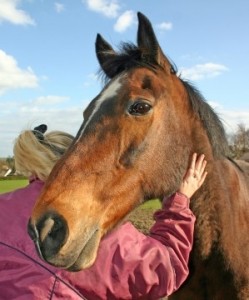 I’ve recently been exposed first-hand (or should I say, “first-hoof?”) to Equine Guided Education (EGE) – working with horses in leadership development and coaching – through the work of The Flag Foundation for Horse/Human Partnership here in northern California.
I’ve recently been exposed first-hand (or should I say, “first-hoof?”) to Equine Guided Education (EGE) – working with horses in leadership development and coaching – through the work of The Flag Foundation for Horse/Human Partnership here in northern California.
It has been a moving, thought-provoking and powerful experience to work with the horses and their human partners.
On my most recent visit, I was struck by the parallels between working with the horses and the Four Principles of Open Space Technology.
Open Space?
Open Space Technology (OST) is a meeting or conference methodology that is, as Wikipedia so succinctly says, “most distinctive for its initial lack of an agenda, which sets the stage for the meeting’s participants to create the agenda for themselves.”
What I love about it is its fundamental assumption that the participants are the experts and that they bring the answers with them. This flies in the face of the traditional “banking method” of education (thank you, Paulo Freire) in which experts deposit information in the minds of the students.
The Four Principles
Here are the Four Principles of OST – as I apply them to Equine Guided Education:
- “Whoever comes is the right people.” In this setting, one isn’t sure which horse or horses will decide to participate, but whoever comes is just right.
- “Whatever happens is the only thing that could have.” As often happens when working with groups and even with individuals, I am often surprised and delighted by what happens – despite my best planning. The same thing is true here, and I am reminded to be honest about what I can control and what I can’t.
- “Whenever it starts is the right time.” Creativity and Spirit – and the horses – don’t pay much attention to the clock.
- “When it’s over, it’s over.” As Kimberly Carlisle, the foundation’s Executive Director said to me, “When the horses are done, they’re done.” They can have incredibly long attention spans if there is still work to be done (or fun to be had), but when it’s done, or the bonds of authenticity are broken, they’re done. I can learn a lot from them about not forcing things.
The Law of What?
I shared this with Lisa Heft, who then introduced me to Eva Svensson (thank you, Lisa!), who is both an OST facilitator and EGE practitioner in Sweden (where EGE is known as HAE). Eva agreed and went on to add that OST’s one law, the “Law of Two Feet” (or more appropriately the “Law of Mobility”) also applies.
The Law of Mobility states that “If, during our time together, you find yourself in any situation where you are neither learning nor contributing, use your two feet and go to some more productive place.” That’s kind of revolutionary, isn’t it? The One Law not only places responsibility for learning on the participants, it also creates “bumblebees and butterflies” who float from one group to another, potentially pollinating as they go.
As Eva said, “If they (the horses) don’t think you are interesting enough, they take their hooves and walk away.”
And if they stay, you know it’s because they want to.
And Something Magical Happens…
Both OST and EGE have facilitators, and structure within which, well, magic can happen. How does that magic happen?
Like OST, EGE assumes the intelligence and the gifts that the participants bring with them – all of the participants. Including the horses. All of that intelligence and all of those gifts in one place combine and recombine and have the potential to produce something totally unexpected: Insights. Collaboration. Connection.
How can you not love that?
Are you curious?
Would you like to learn more about The Flag Foundation for Horse/Human Partnership and Equine Guided Education? Visit http://www.theflagfoundation.org/.
Want to learn more about Open Space Technology? Visit http://www.openingspace.net/openSpaceTechnology.shtml
Want to explore having an experience with OST or EGE?
Email me at susan at susantblake.com.
Want to join the conversation? Leave a comment!
Image: FreeDigitalPhotos.net


 Twitter
Twitter LinkedIn
LinkedIn Facebook
Facebook